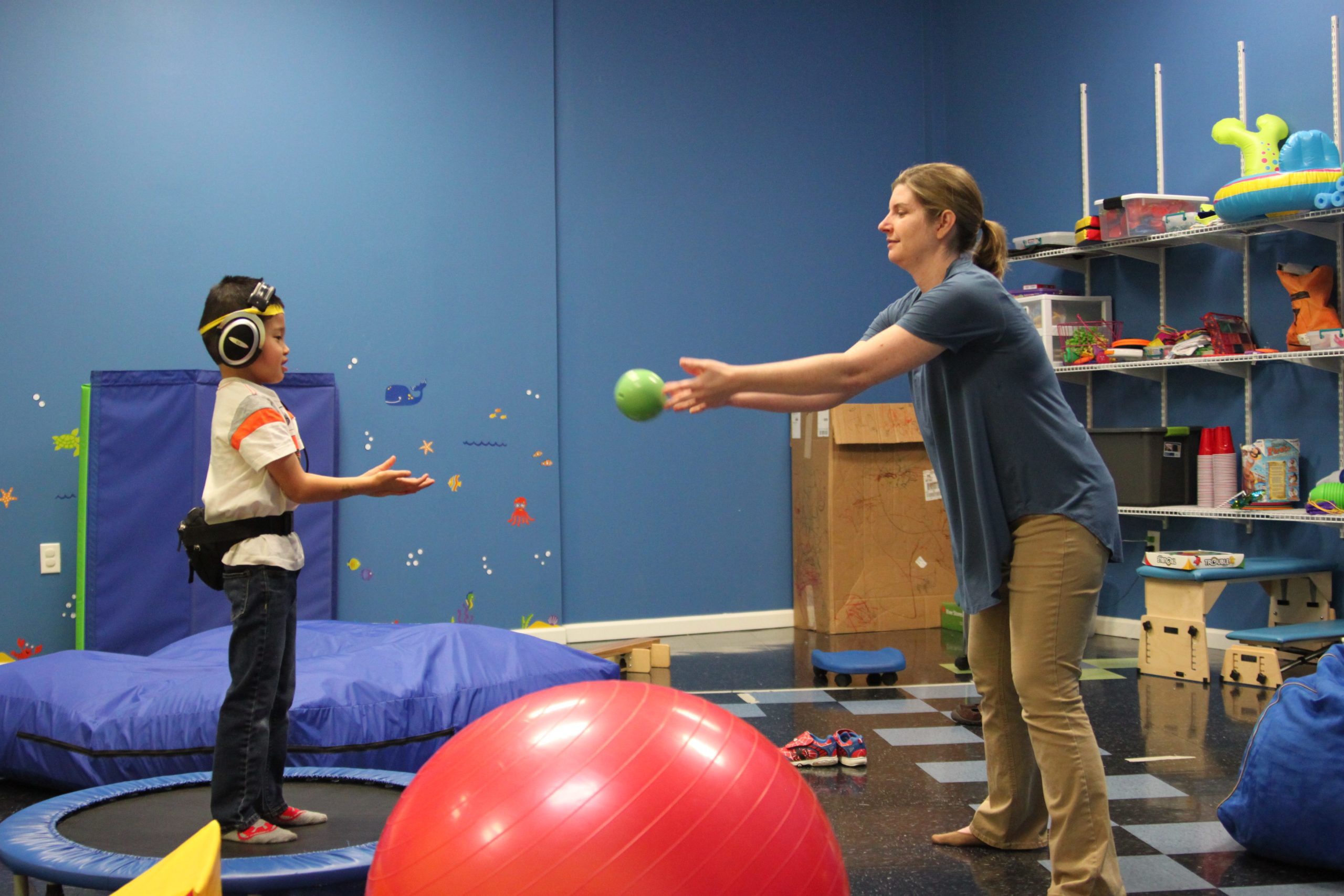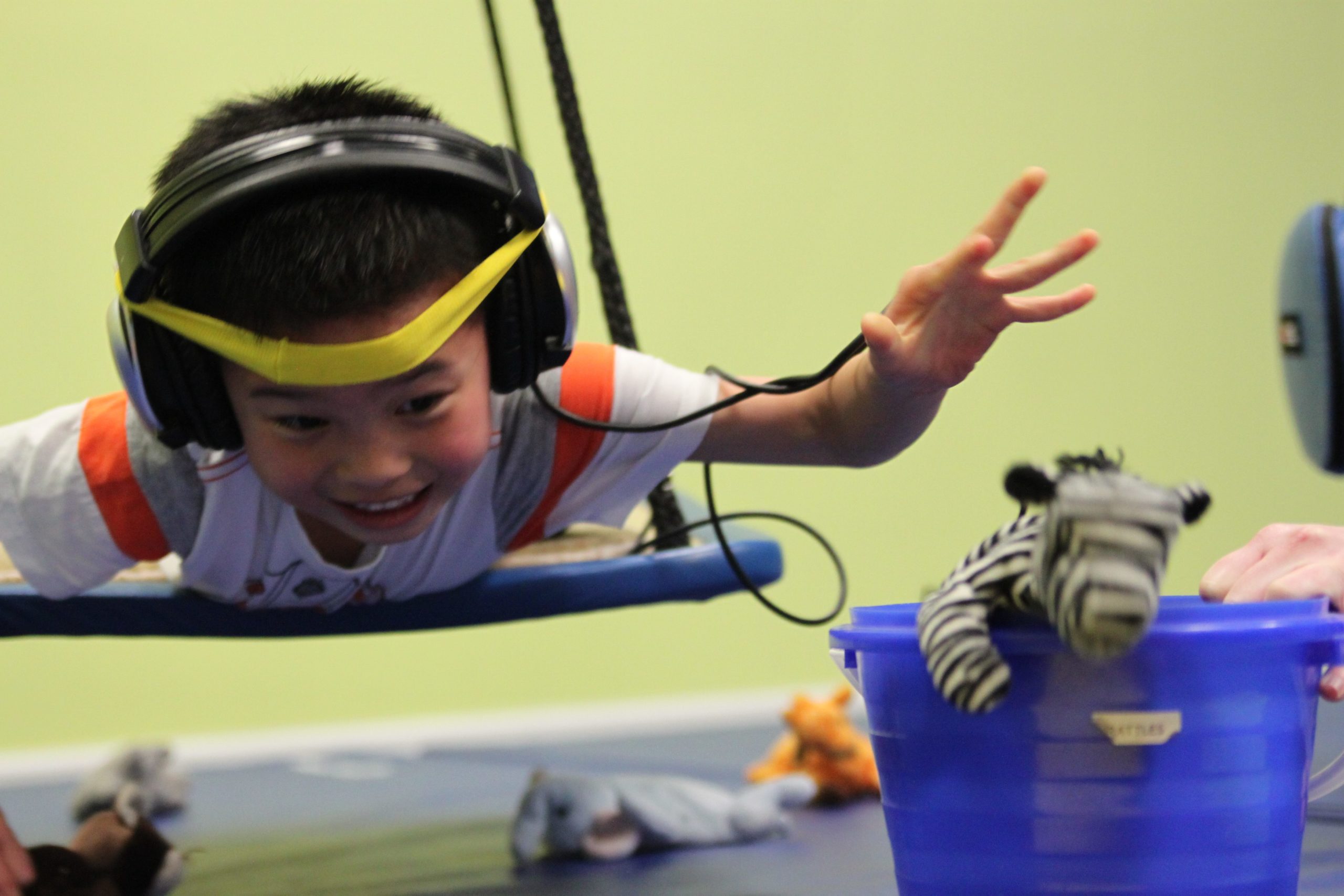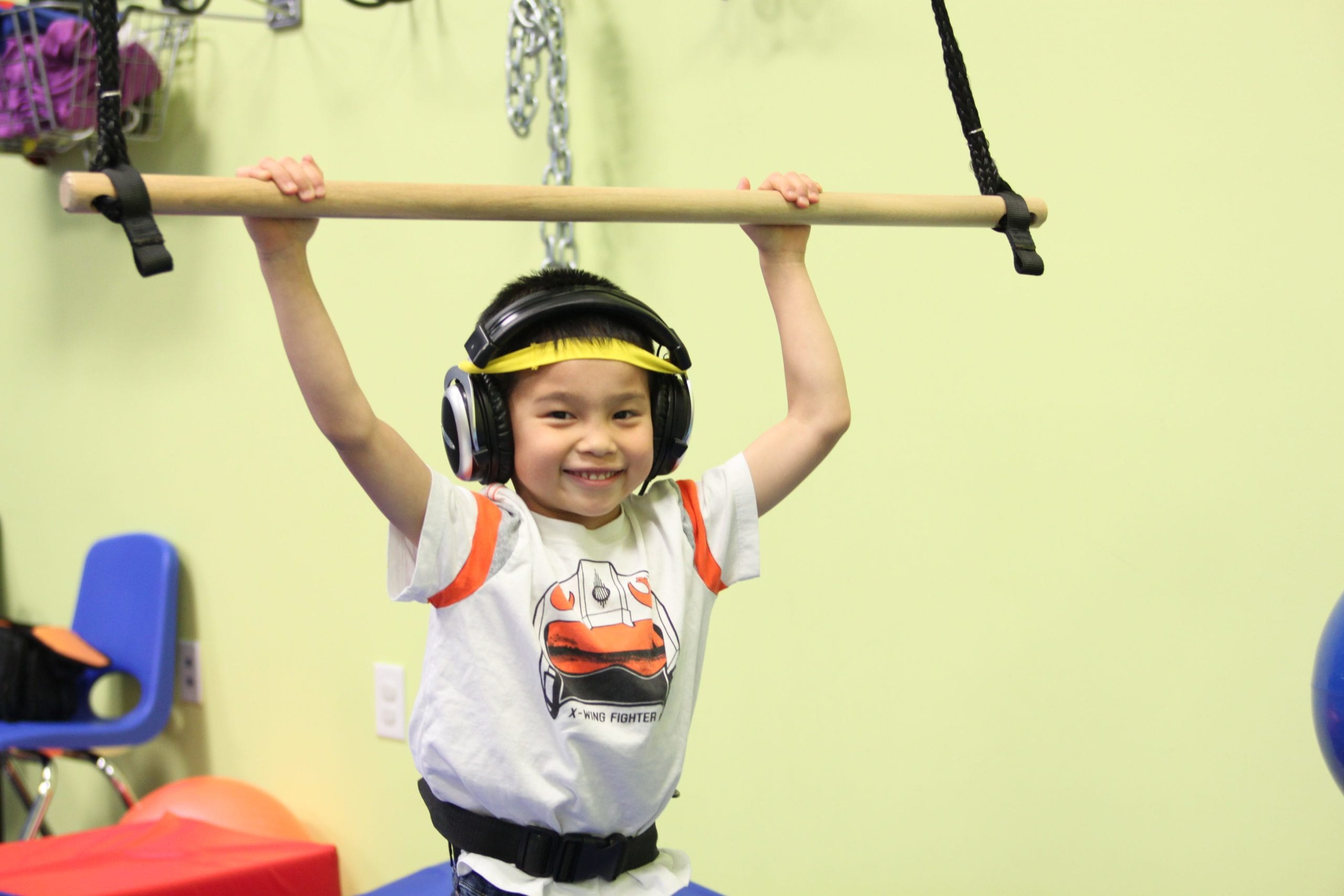

Many people often hear the term “occupational therapy” and picture someone who has suffered a major accident re-learning how to eat or write. However, occupational therapy extends well beyond that limited view, and understanding the important role it can play in children’s lives is essential to knowing tools that are available to help children be as successful as possible.
When children have been exposed to traumatic situations, such as neglect, major life disruption, or a continual lack of felt safety, the development of their brains can get “stuck” in survival mode, resulting in behavior that mimics ADHD, a mind and body struggling with dysregulation, and a lack of age-appropriate social and emotional skills. Furthermore, sensory processing disorders or challenges can also be a long-term effect of trauma. Even when these children come home with safe, loving families, their brains may need additional help to begin to recover and function in society. Occupational therapy may be able to give tools to children and families to help them with this process.
To give more insight into this topic, we talked with Rachel Ashcraft, a licensed and registered occupational therapist working at Child’sPlay Therapy Center in Hoover, Alabama. Rachel has also presented at the local, state, and national level on various topics related to pediatric occupational therapy including topics specific to adoption and foster care. She was gracious to talk with us and answer questions about how occupational therapy could impact families in a positive way.
- What is occupational therapy and what is the focus of occupational therapy for children?
Occupational therapy is a profession who uses “occupations,” or the activities that we all value and do every day, to help people live their life to the fullest. The actual therapy sessions or structures can look very different depending on the client, his or her age, and what occupations or activities they need to do. For children, the focus of occupational therapy is to address any developmental, physical, social, emotional, or mental health needs that may be impacting the child’s ability to fully engage in their home, community, and school environments.
- Can you explain what occupational therapy could address for children from trauma?
Therapy will vary depending on what the child’s needs are. . . . I work at Child’sPlay Therapy Center, and we see children with all kinds of different needs. I would say that a lot of the children we see have “hidden” needs. That means, to the outside observer this child wouldn’t appear to have any delays in ability. However, when we look closer we often find that a child may have sensory processing needs, visual perception delays, fine and/or gross motor coordination delays, neurological processing needs related to a history of trauma, or difficulties with social–emotional coping skills. Occupational therapists will assess the child’s daily function and work with the child to build the skills they need to be successful in their day.
- What kinds of things could families look for to know if they should take their child for an evaluation by an occupational therapist?
Well, first, it’s my belief that if a child has experienced early adversity of any type (especially if the child has been adopted or has been in foster care) that an occupational evaluation is warranted. This is because we know that early adversity is, in itself, a risk factor in regard to the ability to participate effectively in the school, home, and community. Many sensory-based needs can correlate with trauma that a child has experienced. Bruce Perry’s research and work has demonstrated the neurological needs that many of our children with difficult histories experience. You can learn more about his trauma informed model at (www.childtrauma.org).
As far as specific issues and red flags to look for I’d say to assess if your child has difficulty with daily tasks that would be appropriate for their age including the following tasks: tolerating and participating in getting dressed, transitioning from one activity to another, engaging with peers, following directions (as appropriate for their age), sensory needs, and behavior needs. Many children who really need occupational therapy and can improve can be mislabeled as “misbehaving” when they actually have true neurological delays that are guiding their behavior. An occupational therapist can help address the underlying needs that their behavior is communicating.
- How does a family seek a referral for occupational therapy?
There are several different models and ways to access occupational therapy. Different models also have different levels of intensity, qualifiers for access, and general foci of therapy.
1) Early Intervention is state provided therapy, which is primarily focused on family training. A child must fall below specific benchmarks to qualify for EI. Your pediatrician can make this referral and early intervention is provided through your county.
2) School-based therapy is state provided therapy, which is focused on meeting the child’s needs as relates to their academic goals. A child must fall below certain benchmarks to qualify for school-based therapy. Additionally, a child must qualify for other special education services to access school-based occupational therapy. Ask your special education coordinator at your public school about an evaluation if you think your child may need special education services.
3) Outpatient therapy is client and family centered. This means that the goals the therapist addresses will be guided by the child and family’s goals. A physician, dentist, chiropractor, optometrist, or nurse practitioner can make a referral to outpatient occupational therapy. At Child’sPlay Therapy Center, where I work you can call and our office will walk you through exactly what steps you need to take to set up an evaluation. In my opinion, outpatient therapy provides the best environment to address underlying needs that many of our adopted and foster children experience.
- What would I expect from an occupational therapy evaluation?
This will vary depending on the setting (EI, school, or outpatient) but for outpatient therapy you can expect that your therapist will want to understand the child’s medical and social history as well as what activities, routines, and roles are important in your family. When you arrive for an OT evaluation, most OTs will do their best to make you and your child feel comfortable. Many OTs will begin the evaluation with some play activity to build rapport with the child. It’s very different than a doctor’s office visit! Some testing may be completed to evaluate underlying skills such as coordination or visual perception skills. These tests are typically not tedious in the way that IQ or diagnostic testing often is. The OT will also likely want the parent to complete a sensory profile. During the evaluation, it’s likely that the OT will complete several activities with your child that look a good bit like play. This is because play is the language of children and is usually the best way to assess a child’s social, coordination, and sensory needs.
- How can occupational therapy help give families tools to address those issues?
All occupational therapists working with children should be working with the whole family to equip you to know how to best help your child at home. Your OT can help you structure your morning and bedtime routines to meet your child’s needs, design activities at home to build connection and attachment, implement sensory regulating strategies, and provide home programs to continue to build skills.
- Basically, what should we look for in an occupational therapist?
As a mom to an adopted son and a foster mom as well, I would recommend looking for a therapist that at a minimum has received additional training in sensory processing and has some level of awareness of how trauma impacts a child’s development and needs.
If at all possible, it would be great if you had a therapist who is well versed in sensory processing, was trained in specific sensory modalities like integrated listening system and interactive metronome, and had received quality trauma informed training. As trauma informed care becomes more ubiquitous a term, there is becoming a spectrum as far as the quality of training goes in regard to trauma informed practice. There’s no official “benchmark” of what makes a training quality but I’d recommend any trainings from any of the authors of the information sheets noted above, AOTA (in person or in published works), or a trauma informed model such as TBRI, NMT, Theraplay, or Trauma based CBT to name a few.
However, another consideration that is just as valid is if the therapist you are working with has good rapport with you and your child. No training in the world matters if you or your child is not comfortable. Therapeutic alliance (basically everyone trusting each other and knowing you are all on the same team) is probably the most important factor to look for of anything.
- Why is it important for an occupational therapist to be trained in trauma?
This is crucial because we are learning, as evidence emerges and is published, that the sensory based needs of children who have experienced trauma are not the same as children who may have sensory needs related to another medical diagnosis. Additionally, the importance of building connection and establishing trust with the child is always foundational. Trauma informed care is becoming more recognized but is still an emerging area of practice as of right now. Don’t be afraid to ask a clinic or therapist what training they have in this area. If you are investing your resources for someone to help your child, you deserve to know if that person is qualified. You have a right to know a clinic’s approach to treating children who have experienced trauma.
- What do we do if we don’t have any trauma- or sensory integrative-trained therapists in our area?
I’d provide the following information sheets to a therapist if they aren’t trained in trauma and there aren’t any therapists in your area who are trained as a starting point.
AOTA Childhood Trauma Info Sheet
As you and your family navigate the journey of adoption or foster care, the need for extra support can be evident right away or may not surface for many years. If you have questions about challenges or just everyday life that your family is experiencing, please contact our Post-adoption team or our Counseling team at 205-967-0811 or email us here.
About Rachel Ashcraft:
Rachel Ashcraft is a licensed and registered occupational therapist. Rachel received a Bachelor of Science Degree in Food Science, Nutrition, and Health Promotion from Mississippi State University and received a Master of Science degree in Occupational Therapy from UAB. She currently serves as co-chair of ALOTA committee of Government Affairs and participates in AOTA pediatric school of mental health workgroup. Rachel has specialty training in the following areas: Handwriting without Tears, Interactive Metronome, Integrated Listening System, Sensory Processing and Integration, Feeding Intervention with Pediatric Feeding Institute. Rachel presents locally and nationally on the topic of trauma informed care and occupational therapy and foster care.
She is licensed to provide Cognitive Behavioral Intervention for Tics (CBIT) through the Tourette Syndrome Behavior Therapy Institute (TS-BTI). Rachel has presented at the Autism Society of Alabama Conference, the Alabama State Occupational Therapy Conference, the American Occupational Therapy Association Mental Health Specialty Conference, local foster and adoptive parent conferences and support groups, the North Eastern Adoption Summit, and the American Occupational Therapy Association Conference. Rachel was instrumental in the development and implementation of Focal Point, Child’sPlay’s intensive treatment program for the treatment of ADD/ADHD. Rachel has completed the STAR center level 1 mentorship for treatment of sensory processing disorder. Rachel is passionate about occupational therapy and loves helping her clients meet their full potential. Outside of work, Rachel and her husband enjoy spending time with their son and advocating for children in the foster system.






